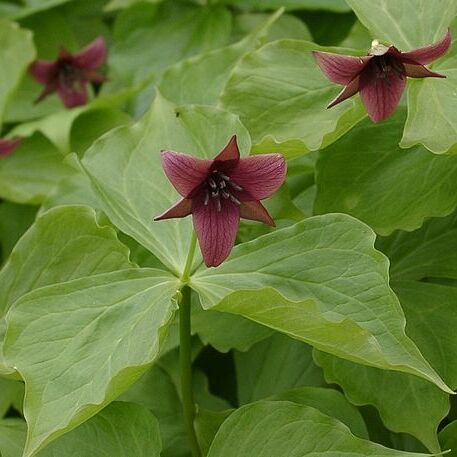Herbs, perennial, scapose, rhizomatous; rhizomes subterranean, horizontal or semierect, monopodial, unbranched or weakly branched, elongated to thick and fleshy, compressed-shortened, distal end tapered to point or praemorse, apex bearing large terminal bud, numerous cataphylls, and contractile, adventitious, ringed roots. Scapes arising from terminal bud or axil of adjacent cataphylls, aerial (subterranean in T. petiolatum), erect, straight (decumbent, S-shaped in T. decumbens and T. reliquum). Bracts on mature plants in whorl of 3, uniformly green or mottled, foliaceous, petiolate or sessile, venation palmate-reticulate, with 3–5 major veins, ovate or obovate to elliptical. Inflorescences terminal, 1-flowered. Flowers: some totally to partially syncarpous, pedicellate or sessile; sepals persistent, 3, distinct, green, maroon, or with maroon markings, foliaceous, oblong, ovate, or lanceolate, alternating with bracts; petals shriveling after anthesis, typically 3, erect, spreading, or recurved, distinct, red, purple, pink, white, yellow, green, or combination of these, ovate or obovate to linear, sometimes clawed; stamens 6, alternating in 2 whorls of 3, erect, incurved, or divergent; filaments mostly short, basally expanded; anthers 2-locular, ± equaling or longer than filaments, dehiscence extrorse, latrorse, or introrse; connectives flat between (or in some species extending beyond) anther sacs; ovary superior, proximal portion 3-locular, 3-or 6-lobed, some axile, some parietal or a combination of both, distal portion forming stigmas; stigmas often persistent, 3, spreading, twisted, or erect, sometimes connate, sessile or with very short style, linear to subulate. Fruits capsular or baccate, fleshy with obscure sutures, not or rarely dehiscent along sutures, each shed as unit through abscission of thin-walled cells at base. Seeds many, elliptic, 2–4 mm, bearing white or yellowish, large, oily, myrmecochorous elaiosome (aril). x = 5. 2n = 10 in all American species recorded.
More
Herbs perennial, usually with stout rhizome. Stem erect, simple, basally with a few brown, scalelike sheaths. Leaves 3, in a terminal whorl, sessile or shortly petiolate, rhombic-orbicular to ovate, with 3 or 5 main veins and anastomosing veinlets. Flowers bisexual, solitary, terminal, pedunculate. Tepals 6, in 2 whorls, free; outer ones usually green, persistent; inner ones petaloid, rose purple to white, slightly narrower than outer, withering or deciduous after anthesis. Stamens 6; filaments short; anthers basifixed, linear, with very short connective. Ovary ovoid to globose, 3-loculed; ovules several to many per locule. Style short, deeply 3-lobed often to base. Fruit a berry, globose to ovoid. Seeds several to many, ovoid, small.
Tep distinct, the sep herbaceous and generally green, the pet white or colored; stamens hypogynous; filaments mostly short; anthers linear, basifixed, sometimes with a prolonged connective; ovary trilocular, 3-lobed or 3-or 6-angled or-winged; style short or none; stigmas 3, ± elongate, usually divergent; fr a many-seeded berry; herbs from a usually short and stout rhizome, the erect stem bearing a single whorl of usually ample, ± net-veined lvs and a single large, terminal fl. Most spp. with white fls produce pink or rarely maroon forms, and spp. with maroon fls likewise have occasional forms with yellow, green, or more rarely white fls. 50, N. Amer. and e. Asia. Spp. 5–8 and 11–13 ± confluent.

